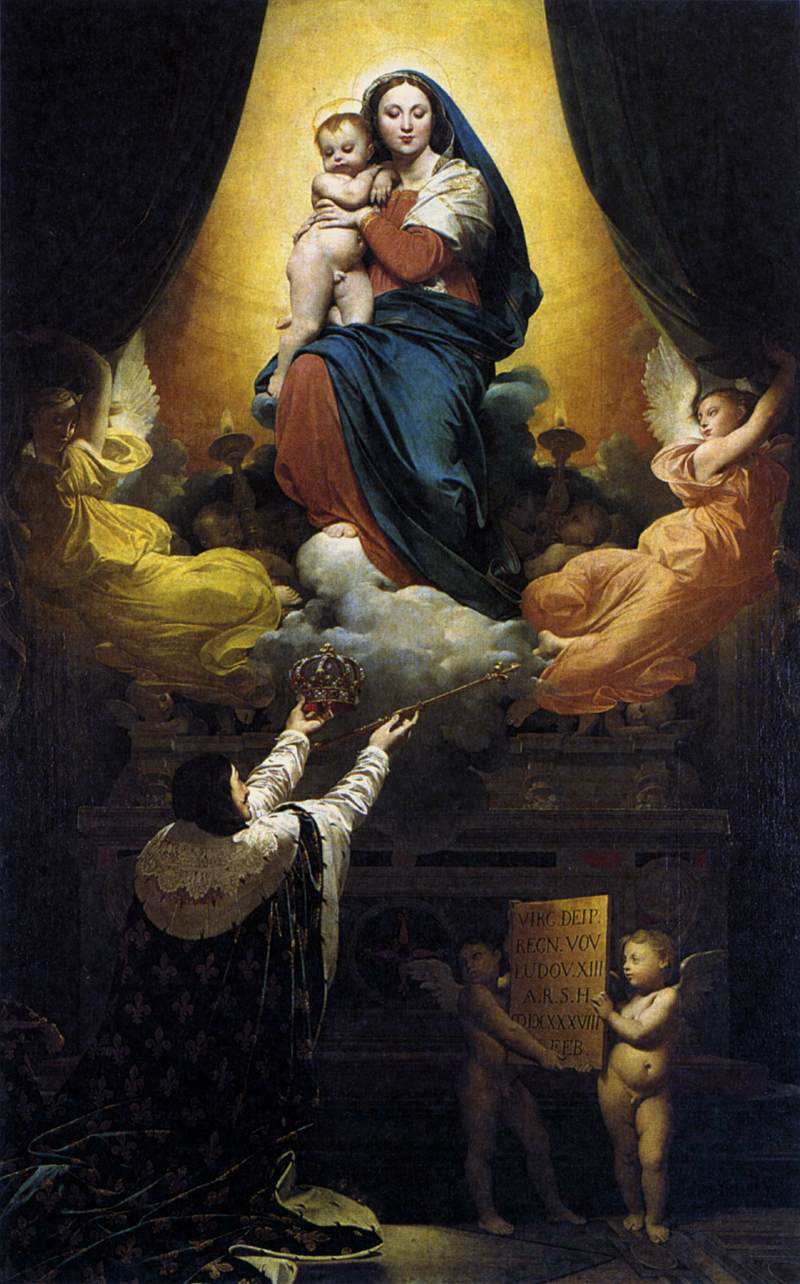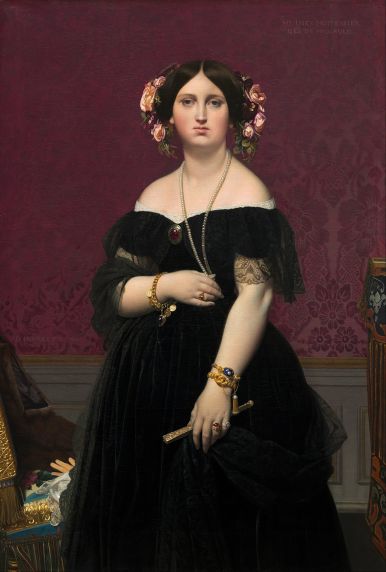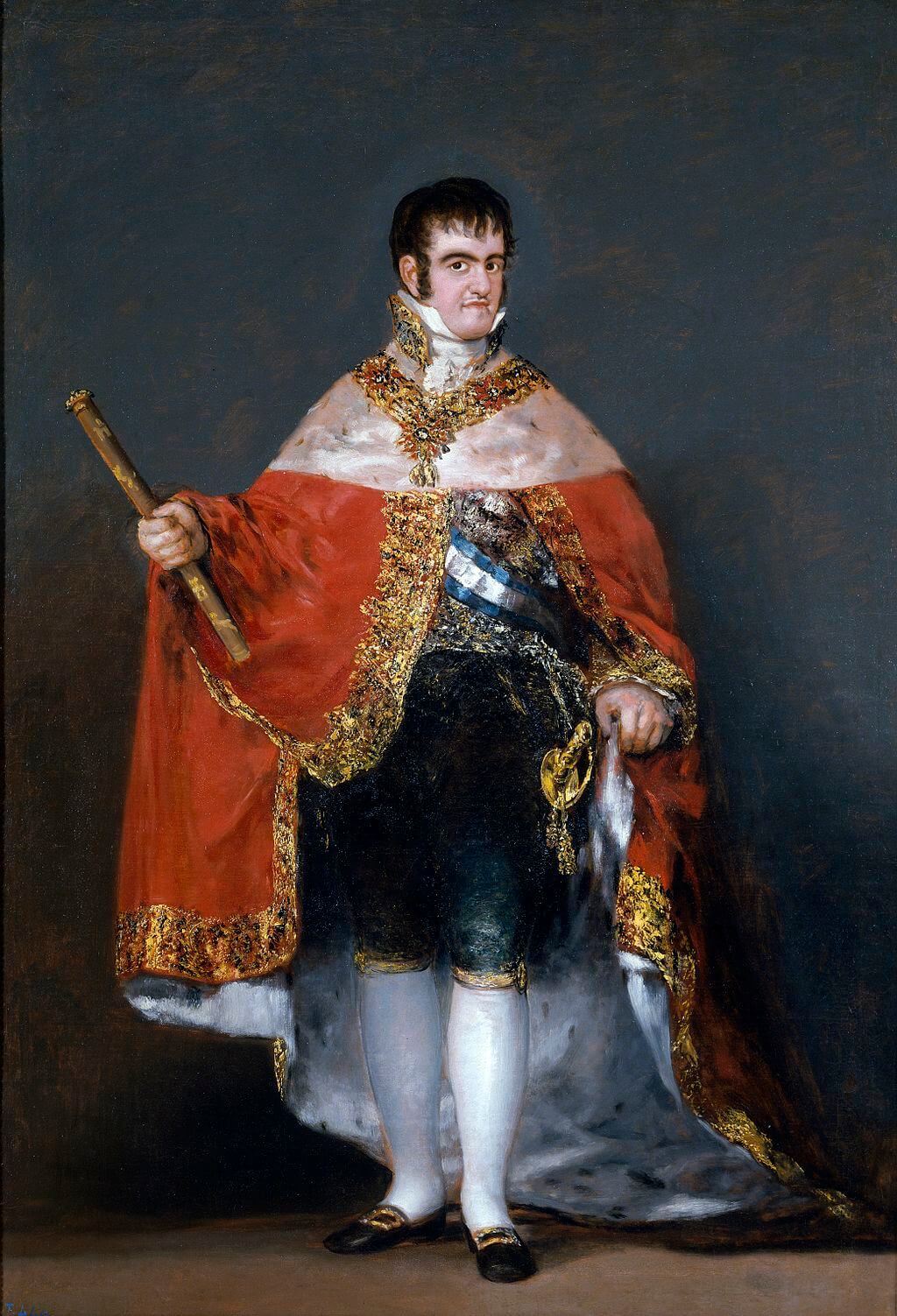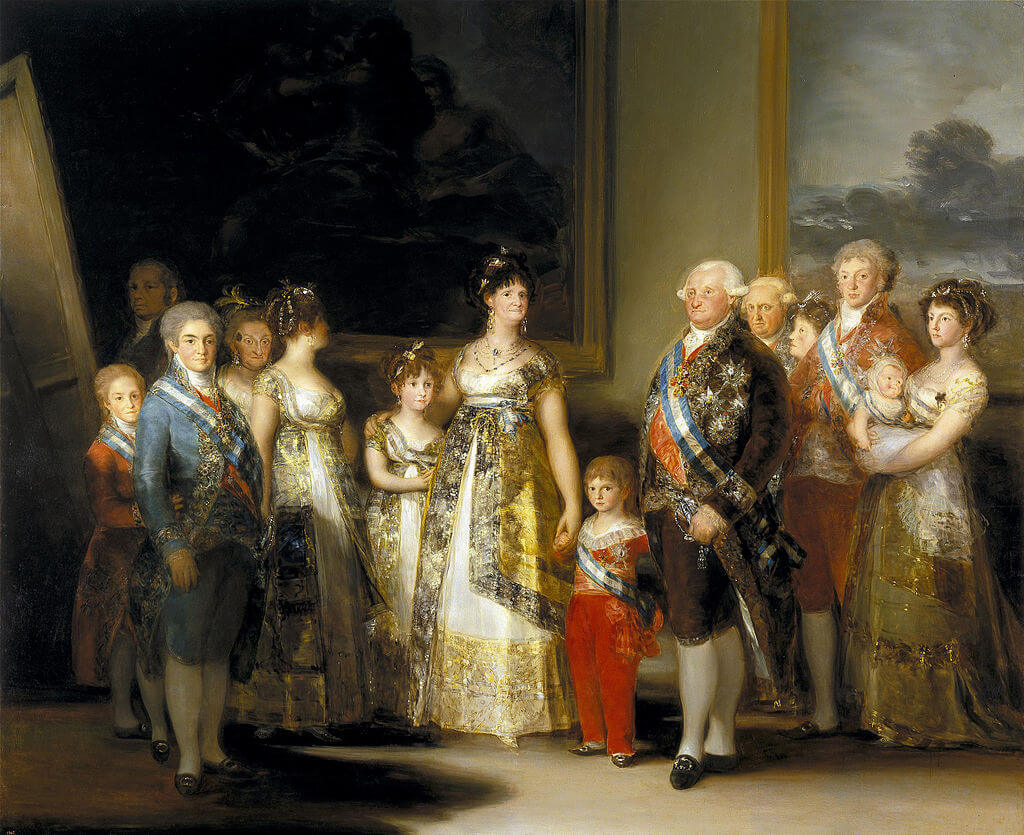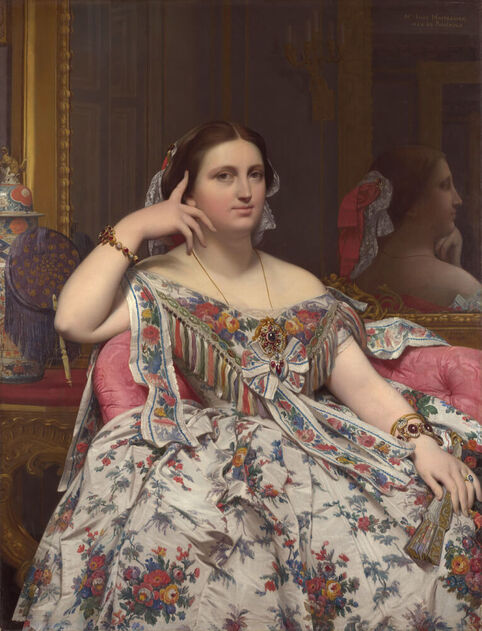|
Where? Gallery 56 of the National Gallery of Art
When? 1851 Commissioned by? Paul Sigisbert Moitessier, the husband of Madame Moitessier. What do you see? Madame Moitessier is standing firmly and wears a black velvet dress with black lacing and a black lace band on top. She also has a black lace shawl wrapped around her middle. She seems to be ready to go to a party or the opera. Her face is symmetric and she was considered to be a very beautiful woman during her time. She stands against a pinkish background decorated with a flower pattern. Her neck and shoulders contrast nicely with the dress and the background. Notice how the neck transitions into the shoulders and how the shape of the shoulders looks a bit unrealistic. Her gaze is unfocused and resembles a bit the ancient Greek sculptures. In her right hand she holds her pearl necklace, and she has a folding fan in her left hand. She is richly decorated with jewelry to show her wealth. Her hair is beautifully decorated with roses. On the right, you can see a reading desk or mantel. On the left is a chair with a glove, a handkerchief, and a fur rug on top of it. Backstory: Madame Moitessier and her husband initially wanted a painting of her seated together with her daughter, but Ingres did not complete that painting until five years later. In 1851, they agreed on another portrait of her standing (which is this painting). Ingres completed this standing portrait within several months. Madame Moitessier was not completely happy with the painting. She found her arms to big and her eyes too far apart. Who is Madame Moitessier? Marie-Clotilde-Ines Moitessier (1821–1897) was the wife of Paul Sigisbert Moitessier, a wealthy banker and merchant who was about twenty years older than her. She was also known by her maiden name De Foucauld, which is the name inscribed at the top right of this painting. Madame Moitessier was the aunt of Charles de Foucauld, a famous French priest who was beatified by the Pope in 2005. Another portrait of Madame Moitessier: In 1856, Ingres finished another portrait of Madame Moitessier currently on display in the National Gallery in London. He started with that painting in 1844, but it took him 12 years to finish that work.
What is Neoclassicism? An art movement that started in Rome in the middle of the 18th century drawing inspiration from the classical period in ancient Greece and ancient Rome. Some of the main Meoclassical artists include Antonio Canova, Giovanni Paolo Panini, Jacques-Louis David, and his student Jean-Auguste-Dominique Ingres.
Neoclassic art is inspired by the old Roman and Greek art and focuses on simplicity and symmetry. The paintings, sculptures, and architecture in this style did not show much emotion, were more ordered and down-to-earth compared to the baroque style, and less playful compared to the rococo style.
Fun fact: One of the reasons that Ingres is considered to be a great portrait painter is that he started from scratch. He hired a nude model similar in shape to the person he wanted to paint (as those rich persons did not want to model nude) and started by drawing the body contours of that model. In that way, he could better paint how the dress would fit around that body. He put a lot of time into this initial stage. For example, if the model would wear a corset under the dress (which is probably the case for Madame Moitessier) he would first add the corset to the naked body before painting the dress.
Interested in a copy for yourself? Poster
0 Comments
Where? Room 702 on the first floor of the Louvre
When? 1814 What do you see? A young courtesan rests atop some brightly colored blue and ochre fabrics from the east. She is surrounded by treasures from the orient—a bejeweled mirror just behind her, a red hookah at her feet, and beautiful patterned drapes that hang from above. She is nude, except for the exquisite oriental headdress atop her head and a few golden bracelets on her wrist. Her elongated right arm holds a beautiful peacock feather fan. She is modestly seductive, her eroticism simultaneously augmented and veiled by the mysticism of the east. Backstory: La Grande Odalisque was commissioned in 1813 by Napoleon’s sister, Caroline Murat, the Queen of Naples. The painting was admitted into the Salon of 1819 but received harsh criticism for a number of reasons. Firstly, this nude by Ingres was different from many reclining nudes of the past as those were painted in a mythological context, making them more appropriate for public display. The most famous work in this genre is the Venus of Urbino by Titian. Ingres, instead, veiled his nude in the mysticism of the east, a theme emphasized by many neoclassical painters like David and Delacroix. Nonetheless, the eroticism caused much discourse. Secondly, Ingres received criticism for his exaggerated and inaccurate rendition of human anatomy. Influenced by the 16th-century Mannerism art movement, Ingres elongated the body of his subject in numerous areas including her spine, right arm, and left leg.
Who is Ingres? Jean-Auguste-Dominique Ingres was a French painter born in born in 1780 in Montauban. His father was an artist and musician, and his mother was a wigmaker. His parents exposed him to the arts from an early age; he enrolled in art school, studying both sculpture and painting.
In 1797, Ingres began studying with Jacques-Louis David, and, in 1799, he was admitted to the Ecole des Beaux-Arts in Paris. Eventually, he won the Grand Prix de Rome, a prestigious art prize that allowed him to work in Rome for five years. While in Rome, he was commissioned by the Murat family in Naples to paint several portraits, though he never received payment for these paintings because of the fall of Napoleon’s empire. Stranded in Rome with no patronage, Ingres resorted to making portraits for English tourists. Soon, Ingres returned to France where he regained popularity with his The Vow of Louis XIII. However, he also continued to paint portraits including his portraits of Madame Moitessier, of which one version is in the National Gallery in London and another version in the National Gallery of Art in Washington, DC.
Fun fact: When looking at the woman, you can clearly see in her lower back that she has a few more vertebrae than normal. Critics of La Grande Odalisque often estimated that Ingres had added three extra vertebrae to his figure. However, a study conducted in 2004 showed that Ingres had actually added approximately five vertebrae to his model. This number was calculated by measuring female models and scaling them to the size of Ingres’s painting. Such an elongation suited the personal taste of Ingres who was influenced by Mannerism. He thought long and curved lines accentuated the sensuality and beauty of a figure.
Where? Gallery 299 of the Philadelphia Museum of Art
When? 1812 Commissioned by? Count Camille de Tournon, the son of the Countess de Tournon What do you see? A portrait of the about 60-year old Countess of Tournon sitting in an armchair against a brownish background. This painting often leads to some discomfort among the viewers. Unlike most other portraits by Ingres, the countess is not a young and beautiful woman. Most people agree that she is not very attractive. Ingres has depicted her quite realistically. For example, her eyes are a bit swollen, she has a very large nose, she has a faint mustache, and she has a bit of a double chin. She also has a wart in between her eyes. However, Ingres has probably also idealized some other parts as the Countess does not look like 60 years old. For example, look at her unwrinkled face and her smooth arms. Instead of her beauty, the painter has focused on depicting her alertness, wisdom, and confidence. She has a small, but confident, smile and looks directly at the viewer. She is dressed in expensive and fashionable clothes. She wears a white transparent veil with flower decorations in her hair, a lace ruff around her neck with a transparent undergarment of lace below it, and a green velvet dress. Over the armchair and on her lap lays a cashmere shawl with flower patterns. Backstory: This painting is also referred to in French as Comtesse de Tournon. Ingres created this painting while he was staying in Rome, which was at that time part of the French empire of Napoleon. The Countess of Tournon was born as Geneviève de Seytres Caumont and is the mother of Philippe-Marcellin Camille de Tournon-Simiane. Between 1809 and 1814, Camille de Tournon was the French Prefect of Rome during Napoleon’s reign. During a cleaning of the painting in 1995 by the Philadelphia Museum of Art, the wart was discovered in between the eyes of the Countess. As the painting stayed for a long time in possession of the Tournon family, it is likely that a family member has applied some extra paint to this work after it was finished to conceal the wart. Who is Ingres? Jean-Auguste-Dominique Ingres was born in 1780 in Montauban in the South of France and died in 1864 in Paris. His father was an artist himself, and from an early age, he provided Ingres with very good art education. In 1797, he became a pupil of Jacques-Louis David, who trained him as a Neoclassical painter. During his life, Ingres lived in Paris, Rome, and Florence. He wanted to become a history painter as that was considered to be the highest level of painting. However, in the early part of his career, he received relatively few commissions for history paintings. Instead, to support his family he created portrait paintings on commission. Portraits by Ingres: Ingres considered himself to be a history painter, but we remember him nowadays mainly because of his beautiful portraits. He has painted a large number of portraits during his career. For example, the two paintings of Madame Moitessier are well-known. The first version hangs in the National Gallery of Art in Washington, DC, and the second version in the National Gallery in London. Two other examples of excellent portraits are Princesse de Broglie in the Metropolitan Museum of Art and the Portrait of Monsieur Bertin in the Louvre.
Fun fact: When a portrait of someone was commissioned, painters usually did their best to depict the person in a beautiful and flattering way. This is also what Ingres usually did as is evidenced by the portraits shown above. However, the Countess of Tournon is not primarily depicted as a beautiful woman.
The realism that Ingres included in this painting is comparable with some of the portraits of the 18th and 19th century Spanish artist Francisco Goya. A good example is the face of King Ferdinand VII of Spain in a portrait that Goya painted of him. Another example is the faces of Charles IV and his family in a painting by Goya in the Prado Museum. Interested in a copy for yourself? Poster or canvas
Where? Room 45 of the National Gallery
When? 1856 Commissioned by? Paul Sigisbert Moitessier, the husband of Madame Moitessier. What do you see? Madame Moitessier is seated on a decorated sofa, also referred to as a canapé. She is wearing a large colorful silk dress with flower patterns. She probably wears a farthingale under her dress, which allows the bottom part of the dress to keep its circular shape. She is looking a bit sensual. For example, look at the blush on her cheeks. Her right hand is casually placed against the side of her head as was often done with Greek statues and she is holding a folding fan in her left hand. You can see the opulence in this painting. Madame Moitessier is wearing expensive bracelets, a ring, a necklace, decorated with various rubies. On the left, you can see a richly decorated screen fan and an expensive vase. Ingres believed that to paint a portrait you have to study the person from all angles and understand all her sides. This is reflected in the mirror that he included in the painting, which shows another side of Madame Moitessier (although it seems unlikely that this mirror is in the correct angle). This side shows her more naturally, with less jewelry. You can also see a candle tree in the mirror. Backstory: Ingres started with this painting around 1847, but only completed it in 1856 when he was 76 years old. He first got the invitation to paint a portrait of Madame Moitessier in 1844, but he refused that assignment as he was focused on mythological paintings. However, when he later met her, he changed his mind as he was very impressed by her looks which made him remember of Juno (the so-called Junoesque look, which means that she looked beautiful and dignified at the same time, just like the goddess Juno). Who is Madame Moitessier? Marie-Clotilde-Ines Moitessier (1821–1897) was the wife of Paul Sigisbert Moitessier, a wealthy banker and merchant. She was also known by her maiden name De Foucauld, which you can see by the inscription at the top right of this painting. Madame Moitessier was also the aunt of Charles de Foucauld, a famous French priest who was beatified by the Pope in 2005. Another portrait of Madame Moitessier: In 1851, Ingres painted another portrait of Madame Moitessier that is currently on display in the National Gallery of Art in Washington, D.C. He painted this second portrait while he had not finished the first one yet.
Who is Ingres? Jean-Auguste-Dominique Ingres (1780-1867) was born in Montauban, in the southwest of France. He was one of the primary Neoclassical painters. He considered himself to be a history painter but also painted quite some portraits during his career. Especially early in his career, he painted portraits to sustain himself. Interestingly, nowadays he is famous for the portraits that he painted.
His perfectionism may cause part of this fame. He found it very difficult to complete portraits, and he often got very frustrated and overwhelmed by these portrait assignments. A large part of his frustration came from the fact that the richer women that wanted a portrait could not hold their pose for an extended period of time. They tended to stand up and look at the painting and change the position of their dress and jewelry while he was painting them. In the end, however, he delivered stunning portraits. Fun fact: Ingres started some initial drawings for this painting in 1844. The idea was the Madame Moitessier was sitting with her daughter Catherine at her knee. Ingres, however, became severely frustrated during this process, partly because he found the daughter of Madame Moitessier very difficult to handle. After a few years, he decided that he should eliminate the daughter from this project, though that did not speed up the process. In 1849, the wife of Ingres died and he decided to stop his work on this painting. Only in 1852, after he remarried, he continued his work on this painting to ultimately finish it in 1856. Interested in a copy for yourself? Poster |
Categories
All
|
- Home
- Blog
-
Museums
- Alte Pinakothek
- Art Institute of Chicago
- Baltimore Museum of Art
- Barber Institute of Fine Arts
- Bargello
- Barnes Foundation
- British Museum
- Church of Sant’Anastasia
- Cleveland Museum of Art
- Courtauld Institute of Art
- Detroit Institute of Arts
- Frans Hals Museum
- Galleria Borghese
- Gallerie dell'Accademia
- Getty Museum
- Guggenheim
- Hermitage Museum
- Kunsthistorisches Museum
- Kunstmuseum Basel
- Legion of Honor Museum
- Louvre
- Mauritshuis
- Metropolitan Museum of Art
- Musee d’Orsay
- Museum of Fine Arts in Boston
- Museum of Modern Art
- National Gallery in London
- National Gallery of Art
- National Museum in Poznań
- Norton Simon Museum
- Ny Carlsberg Glyptotek
- Palace of Versailles
- Palazzo Pitti
- Palazzo Vecchio
- Petit Palais
- Philadelphia Museum of Art
- Prado
- Pushkin Museum
- Ravenna Art Museum
- Rijksmuseum
- San Diego Museum of Art
- Santa Maria delle Grazie
- St. Peter's Basilica
- Städel Museum
- Statens Museum for Kunst
- Tate Britain
- Tate Modern
- Timken Museum of Art
- Uffizi
- Vatican Museums
- Wallace Collection
-
Artists
- Altdorfer
- Anguissola
- Berlin Painter
- Bosch
- Botticelli
- Boucher
- Bronzino
- Bruegel the Elder
- Brunelleschi
- Cabanel
- Caillebotte
- Canova
- Caravaggio
- Carpeaux
- Cezanne
- Cimabue
- David
- Degas
- Delacroix
- De Maria
- Donatello
- El Greco
- Fontana
- Fra Angelico
- Fragonard
- Gauguin
- Gentileschi
- Gericault
- Gonzalez-Torres
- Goya
- Hals
- Hogarth
- Hokusai
- Ingres
- Leonardo da Vinci
- Lippi, Filippo
- Longhi, Barbara
- Lorrain
- Makovsky
- Manet
- Massys
- Matisse
- Merian
- Michelangelo
- Mochi
- Modigliani
- Monet
- Panini
- Parmigianino
- Perugino
- Picasso
- Pisanello
- Raphael
- Rembrandt
- Renoir
- Reynolds
- Rivera
- Rodin
- Rubens
- Scultori
- Seurat
- Steen
- Tintoretto
- Titian
- Toulouse-Lautrec
- Turner
- Uccello
- Van der Weyden
- Van Dyck
- Van Eyck
- Van Gogh
- Van Hemessen
- Vasari
- Velazquez
- Vermeer
- Veronese
- Vigée Le Brun
-
Locations
- Books
- About Us






